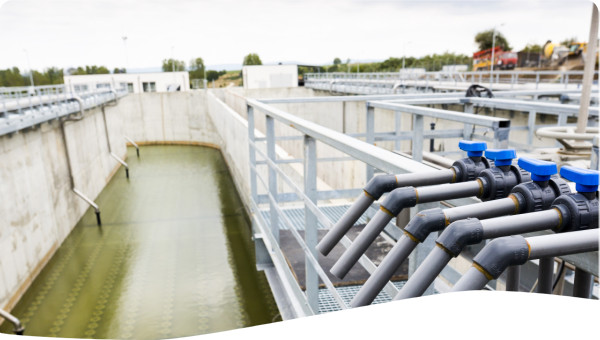The human right to water and sanitation is internationally recognized (Tool A2.05) (UN Committee on Economic, Social and Cultural Rights, 2002). For this right to be fulfilled, profound systems should be in place, including institutional arrangements related to delivering water-related services. Institutional arrangements may be considered one of the building blocks of an effectively functioning governance system in the water realm. Institutions support service delivery models which vary significantly across countries within the following components: policy and legislation, service delivered and its infrastructure, management system and revenue mechanism. Additionally, institutional roles in the system should be identified: service authorities, service providers and service users (Huston and Moriarty, 2018).
Network-based water supply systems such as those found in urban settings are typically made up of the following hydrologic and hydraulic components:
-
Source point – from where raw water resources can be abstracted;
-
Collection point – for the transfer of the raw water resources towards the treatment water facilities;
-
Purification facilities – for the treatment of the transferred water resources;
-
Reservoir facilities – for the storage of potable water;
-
Pressurizing installations – for the pumping (when working against gravity flows);
-
Pipe or channel network – for distributing the water to end-users;
-
Sewage – for the collection, treatment, and release of wastewater;
-
Reuse systems – for the reutilisation of appropriate grey and treated water (i.a., for irrigation).
Unlike households in high-income countries, low- and middle-income households from developing countries rely on more than one source to satisfy their water needs, which is known as multiple water source use. In countries across Asia, Africa, the Americas, and the Pacific centralized piped network is either substituted or supplemented with alternative options (bottled water, jerrycans, wells, boreholes and water trucking), known as small scale water service providers (Elliott et al., 2019).
Water and sanitation services should always be provided in adequate, quality, affordable, accessible, and acceptable supplies (OHCHR, UN-HABITAT and WHO, 2010). Adequate provision refers to delivering the quantities that satisfy end-users needs while considering the capacity of the freshwater source point ecosystems. A well-defined system of property rights and obligations for water, for all uses, should be first developed so that social fairness and integrity can be sustained (Tool A2.01). Providing safe water quality is a responsibility that takes into account both health and environmental aspects. Water providers should comply with agreed national and/or international health standards on water quality and strictly respect environmental standards for the release and reuse of wastewater. Water affordability means that those with limited income should still be able to access water services. Systems of water pricing related to volume and timing, for all applications, should be introduced in order to adequately reflect water value (Tool C5.04). Improved drinking water services should be accessible on premises or within a distance with a collection time that should not exceed 30 minutes, including the waiting time (JMP, n.d.). Water should be of acceptable physical characteristics whereas sanitation should be sensitive to gender (Tool B5.06), vulnerable and marginalized groups, including those with disabilities.
In a nutshell, a water supply and sanitation strategy oriented by IWRM principles is one that should show clear consciousness of the following (GWP, 2000):
-
Water service organisations need to be embedded within broader institutional frameworks, taking into account the natural system plus economic, social and political human systems, including coordinated water sensitive political and economic decision-making (Tool A1.02; Tool D1.01).
-
Participatory approaches should be applied at all levels. Key stakeholders should have their say in every aspect of the water supply and sanitation services, from price regulation to the location of distribution networks.
-
The reuse of grey and treated water is an essential feature of providing integrated water supply and sanitation services.
-
Water should always be provided in adequate, quality and affordable supplies for all. Water services should aim for a careful balance between the social, economic and environmental needs.
-
Providing water and sanitation services will face different challenges according to the setting, thus there is no such thing as "one size fits all". Experience shows that the contrast is particularly stark in providing for rural versus urban areas.
Three types of service delivery models and institutional roles associated with them will be elaborated in this sub-section: Public Water Utilities (Tool B2.01), Private Sector Service Providers (Tool B2.02) and Community-Based Organisations (Tool B2.03), as well as collaborations between them.
- Public water providers are under public control and can be locally, regionally and nationally administered. Public water and sanitation providers can be fully owned and managed by the government, either on a national or local level, or management can be delegated to a state-owned company (Joffe et al., 2008). In terms of financial arrangements, local or national government waterworks may or may not be ring-fenced – i.e., when finances for water services functions are managed and reported separately from other state activities (IBNET, n.d.). Regulatory-wise, in some countries a separate regulatory agency is established to set the terms of supply autonomously from national or local government (World Bank, 2020).
- Private Sector engagement in the form of full privatization or public-private partnership operates under commercial law and defines the degree of the private sector participation (asset ownership, financial obligations, operation and maintenance).
- Community-based water supply and management organisations are the backbone of WASH service delivery in a majority of the developing world, especially in rural areas. Yet, they are often overlooked by regulatory frameworks and thereby mostly operate as an informal sector (Van Ittersum & Van Steenbergen, 2003). Efforts to formalize supported self-supply often fail due to lack of documentation (World Bank, 2017). Traditionally, community-based water supply organisations have had a limited capacity to mobilize external financial support from either governments or private actors (Obosi, 2019).

 Tool -
Tool -

